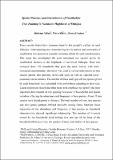| dc.contributor.author | Abiyu, Abrham | |
| dc.contributor.author | Shete, Maru | |
| dc.contributor.author | Gratzer, Georg | |
| dc.coverage.spatial | Ethiopia | en |
| dc.date.accessioned | 2016-01-27T17:00:09Z | |
| dc.date.available | 2016-01-27T17:00:09Z | |
| dc.date.issued | 2012-12 | |
| dc.identifier.citation | Abiyu, A., Shete, M. and Gratzer, G. (2012) Spatial patterns and determinants of smallholder tree planting in Northwest Highlands of Ethiopia, Journal of Agriculture and Development (JAD), vol. 2, no. 2, pp. 18-43. Addis Ababa; St. Mary's University. | en |
| dc.identifier.uri | https://opendocs.ids.ac.uk/opendocs/handle/20.500.12413/8248 | |
| dc.description.abstract | Trees outside forest have immense benefits for people's welfare in rural
Ethiopia. Understanding and characterizing the incentives and constraints of
smallholder tree growers is essential to hasten efforts in rural transformation.
This study has investigated the most important tree species grown by
smallholder farmers in the highlands of northwest Ethiopia. Data was
collected from 150 households that grow the trees. Survey with semi
structured questionnaire interviews was used to collect information on tree
species grown, tree growing niches and uses, as well as, selected socio
economic characteristics. The number of trees and types of tree species grown
by each household was calculated with and without adjusting to farm size.
Linear regression model and other tests were employed to identify the most
important determinants of tree growing behaviour of households and spatial
variables affecting the abundance and frequency of tree species. About 25 tree
species were found grown by farmers. The total number of trees, tree species
and their spatial patterns differed markedly among farms. Multiple linear
regression of tree abundance and frequency of tree species on household
characteristics showed significant relationship. The number of livestock
owned by the household, land holding size and age of the head of the
household affect positively the number of trees and number of tree species grown by the households. Gender affected the species and spatial pattern of
trees. Our result support the proposition that farmers assign their parcels of
lands to land uses that increase the rent value of the land, and this rent value
was affected by spatial variables. Our results suggest that future policy and
extension program should target increasing the number of tree species on
resource endowed households, and increasing the number of trees on younger
and less resource endowed ones. Our finding that farm land and boundary
planting to be important tree growing niche may indicate future intervention
points. | en |
| dc.language.iso | en | en |
| dc.publisher | St. Mary's University, Ethiopia | en |
| dc.rights.uri | http://creativecommons.org/licenses/by-nc-nd/4.0/ | en |
| dc.subject | Agriculture | en |
| dc.subject | Environment | en |
| dc.subject | Gender | en |
| dc.subject | Rural Development | en |
| dc.title | Spatial patterns and determinants of smallholder tree planting in Northwest Highlands of Ethiopia | en |
| dc.type | Article | en |
| dc.rights.holder | St. Mary's University, Ethiopia | en |


